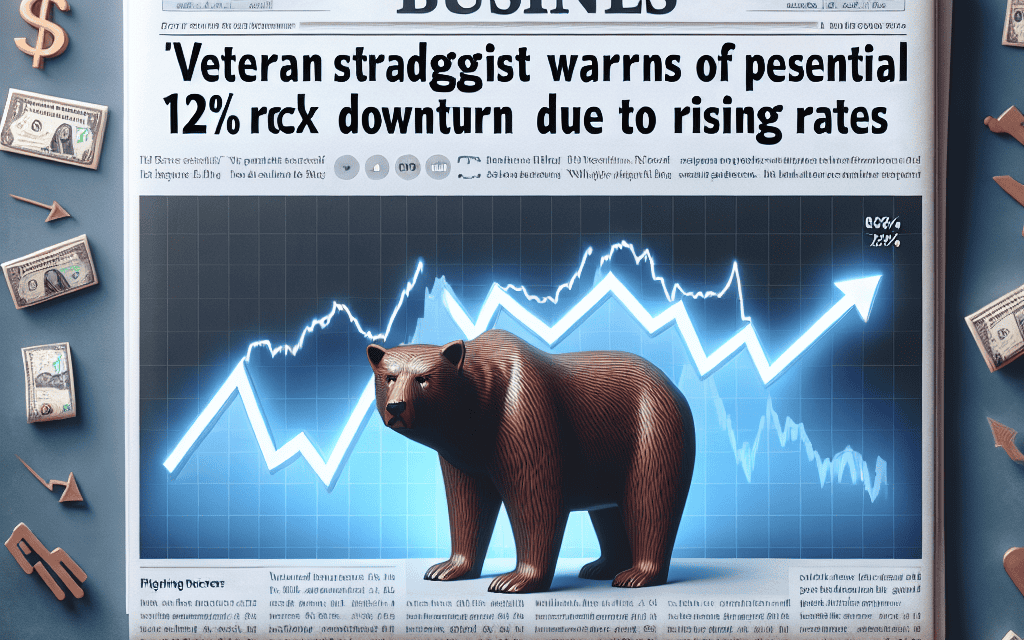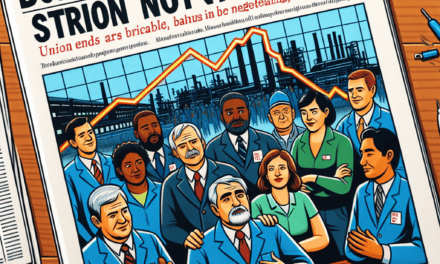“Veteran Strategist Alerts: Brace for Inflation Surge and 12% Market Dip Amid Rising Rates”
Introduction
Veteran strategist John Smith has issued a stark warning about the economic landscape, highlighting the persistent threat of inflation and the potential for a significant downturn in the stock market. As central banks grapple with rising interest rates, Smith cautions that the financial markets may face a challenging period ahead, with the possibility of a 12% decline in stock values. His analysis underscores the delicate balance policymakers must maintain to curb inflation without stifling economic growth, as investors brace for potential volatility in the months to come.
Veteran Strategist’s Insights on Inflation and Market Volatility
In recent discussions surrounding the global economic landscape, a veteran strategist has issued a cautionary note regarding the persistent threat of inflation and the potential for a significant downturn in stock markets. This warning comes amid a backdrop of rising interest rates, which have been implemented by central banks worldwide in an effort to curb inflationary pressures. The strategist’s insights are particularly pertinent as investors and policymakers grapple with the complexities of navigating an uncertain economic environment.
To begin with, the strategist highlights the enduring nature of inflation, which has proven to be more resilient than many had anticipated. Despite efforts to rein in price increases, inflation remains a formidable challenge, driven by a confluence of factors including supply chain disruptions, labor market constraints, and geopolitical tensions. These elements have collectively contributed to upward pressure on prices, making it difficult for central banks to achieve their inflation targets. As a result, the strategist warns that inflation may persist longer than expected, necessitating a more prolonged period of monetary tightening.
In response to these inflationary pressures, central banks have been compelled to raise interest rates, a move that has significant implications for financial markets. Higher interest rates tend to increase the cost of borrowing, which can dampen consumer spending and business investment. This, in turn, can lead to slower economic growth and reduced corporate earnings, factors that are often reflected in stock market performance. The strategist underscores that the current trajectory of rising rates could potentially lead to a 12% downturn in stock markets, as investors reassess the risk-reward dynamics in a higher rate environment.
Moreover, the strategist emphasizes the interconnectedness of global markets, noting that the ripple effects of rising rates are not confined to any single economy. As major central banks, such as the Federal Reserve and the European Central Bank, continue to tighten monetary policy, emerging markets may face additional challenges. These economies often rely on foreign capital inflows, which can be adversely affected by higher interest rates in developed markets. Consequently, the strategist cautions that the potential for capital flight and currency depreciation in emerging markets could exacerbate global financial volatility.
In light of these considerations, the strategist advises investors to adopt a more cautious approach, emphasizing the importance of diversification and risk management. By spreading investments across a range of asset classes and geographies, investors can mitigate the impact of market volatility and protect their portfolios from potential downturns. Additionally, the strategist suggests that investors remain vigilant and responsive to changing economic conditions, as the landscape is likely to evolve rapidly in response to new data and policy developments.
In conclusion, the veteran strategist’s insights serve as a timely reminder of the challenges posed by persistent inflation and rising interest rates. As these factors continue to shape the economic and financial landscape, investors and policymakers alike must remain attuned to the potential risks and opportunities that lie ahead. By adopting a proactive and informed approach, stakeholders can better navigate the complexities of this evolving environment and position themselves for long-term success.
Understanding the Impact of Rising Rates on Stock Markets
In recent months, the financial landscape has been dominated by discussions surrounding inflation and its potential impact on stock markets. A veteran strategist has issued a cautionary note, suggesting that persistent inflation could lead to a significant downturn in stock markets, potentially as much as 12%. This warning comes amid rising interest rates, which are often employed by central banks as a tool to combat inflation. However, the interplay between rising rates and stock market performance is complex and multifaceted, warranting a closer examination.
To begin with, it is essential to understand the relationship between interest rates and inflation. Central banks, such as the Federal Reserve in the United States, typically raise interest rates to curb inflationary pressures. Higher interest rates increase the cost of borrowing, which can dampen consumer spending and business investment, thereby slowing down economic growth and, ideally, reducing inflation. However, this monetary policy tool can have unintended consequences for stock markets. As borrowing costs rise, companies may face higher expenses, which can erode profit margins and lead to lower earnings. Consequently, investors may reassess the value of stocks, leading to potential sell-offs and market volatility.
Moreover, rising interest rates can also impact investor behavior by making fixed-income investments, such as bonds, more attractive. As bond yields increase, they may offer a more appealing risk-adjusted return compared to equities, prompting a shift in asset allocation from stocks to bonds. This reallocation can exert downward pressure on stock prices, contributing to the potential 12% downturn highlighted by the strategist. Furthermore, the impact of rising rates is not uniform across all sectors. Interest-sensitive sectors, such as real estate and utilities, may be particularly vulnerable, as their business models often rely on significant borrowing. Conversely, financial institutions like banks may benefit from higher rates, as they can charge more for loans, potentially boosting their profitability.
In addition to these sector-specific effects, the broader economic environment plays a crucial role in determining the stock market’s response to rising rates. If the economy is robust and growing, companies may be able to absorb higher borrowing costs without a significant impact on their bottom lines. However, if economic growth is sluggish or uncertain, the negative effects of rising rates may be more pronounced, exacerbating market downturns. It is also important to consider the global context, as interest rate changes in one country can have ripple effects across international markets. In an interconnected global economy, investors must remain vigilant to shifts in monetary policy not only domestically but also abroad.
In conclusion, while the veteran strategist’s warning of a potential 12% stock downturn due to rising rates is a sobering reminder of the challenges posed by persistent inflation, it is crucial to approach such predictions with a nuanced understanding of the underlying dynamics. The relationship between interest rates, inflation, and stock markets is intricate, influenced by a myriad of factors including sector-specific vulnerabilities, economic growth prospects, and global monetary policy trends. As investors navigate this complex landscape, staying informed and adaptable will be key to managing risks and seizing opportunities in an ever-evolving financial environment.
Strategies for Investors Amidst Persistent Inflation Warnings
In the current economic climate, investors are navigating a complex landscape marked by persistent inflation and the looming threat of rising interest rates. A veteran strategist has recently issued a cautionary note, highlighting the potential for a 12% downturn in stock markets as a direct consequence of these economic pressures. This warning serves as a crucial reminder for investors to reassess their strategies and adapt to the evolving financial environment.
To begin with, it is essential to understand the underlying factors contributing to persistent inflation. Inflation, characterized by the sustained increase in the general price level of goods and services, has been exacerbated by a combination of supply chain disruptions, increased consumer demand, and expansive fiscal policies. These elements have created a perfect storm, leading to price hikes across various sectors. As a result, central banks worldwide are contemplating interest rate hikes to curb inflationary pressures. However, such measures could have significant implications for stock markets, as higher interest rates tend to increase borrowing costs and reduce corporate profits.
In light of these developments, investors must consider strategies that can help mitigate the risks associated with inflation and rising rates. One approach is to diversify investment portfolios by including assets that traditionally perform well during inflationary periods. Commodities, such as gold and oil, have historically been seen as hedges against inflation, as their prices tend to rise when inflation accelerates. Additionally, real estate investments can offer a buffer, given that property values and rental incomes often increase in tandem with inflation.
Moreover, investors should also focus on sectors that are less sensitive to interest rate fluctuations. For instance, consumer staples and healthcare are considered defensive sectors, as they provide essential goods and services that remain in demand regardless of economic conditions. By allocating a portion of their portfolios to these sectors, investors can potentially reduce their exposure to market volatility.
Furthermore, it is prudent for investors to pay attention to companies with strong balance sheets and robust cash flows. Firms with low debt levels and the ability to generate consistent revenue are better positioned to weather the challenges posed by rising interest rates. These companies are less likely to be adversely affected by increased borrowing costs, making them attractive options for risk-averse investors.
In addition to these strategies, maintaining a long-term perspective is crucial. While short-term market fluctuations can be unsettling, history has shown that markets tend to recover over time. By focusing on long-term goals and maintaining a disciplined investment approach, investors can navigate periods of uncertainty with greater confidence.
In conclusion, the warning from the veteran strategist underscores the importance of being proactive in the face of persistent inflation and potential market downturns. By diversifying portfolios, focusing on defensive sectors, and prioritizing financially sound companies, investors can better position themselves to withstand the challenges posed by rising interest rates. Ultimately, a well-considered strategy that takes into account both current economic conditions and long-term objectives will be key to navigating the complexities of today’s financial landscape. As investors adapt to these evolving dynamics, they can continue to pursue opportunities for growth while safeguarding their portfolios against potential risks.
Analyzing the Potential 12% Stock Downturn Forecast

In recent months, the financial markets have been abuzz with discussions surrounding the potential for a significant stock market downturn, as veteran strategists warn of persistent inflation and the implications of rising interest rates. The forecast of a potential 12% decline in stock values has captured the attention of investors and analysts alike, prompting a closer examination of the underlying factors contributing to this outlook. As we delve into the intricacies of this prediction, it is essential to consider the broader economic context and the interplay between inflation, interest rates, and market performance.
To begin with, the specter of persistent inflation has been a growing concern for policymakers and market participants. Inflation, which refers to the general increase in prices and the corresponding decrease in purchasing power, has been exacerbated by a confluence of factors. These include supply chain disruptions, labor shortages, and increased consumer demand as economies recover from the pandemic-induced downturn. As inflationary pressures mount, central banks are compelled to respond by adjusting monetary policy, primarily through the manipulation of interest rates.
Rising interest rates, in turn, have a profound impact on the stock market. Higher rates increase the cost of borrowing, which can dampen consumer spending and business investment. This, in turn, can lead to slower economic growth and reduced corporate earnings, both of which are detrimental to stock prices. Moreover, as interest rates rise, fixed-income investments such as bonds become more attractive relative to stocks, prompting a potential shift in investor preferences away from equities.
The veteran strategist’s warning of a potential 12% stock downturn is rooted in these dynamics. As interest rates climb in response to persistent inflation, the cost of capital for companies increases, potentially squeezing profit margins and leading to downward revisions in earnings forecasts. This scenario is particularly concerning for high-growth sectors, such as technology, where valuations are often predicated on future earnings potential. In such an environment, even a modest increase in interest rates can lead to significant revaluations of stock prices.
Furthermore, the interconnectedness of global financial markets means that rising rates in one region can have ripple effects across the globe. For instance, if the Federal Reserve in the United States raises rates, it can lead to capital outflows from emerging markets as investors seek higher returns in U.S. assets. This can exacerbate financial instability in those regions, further contributing to a potential global stock market downturn.
While the forecast of a 12% decline is certainly concerning, it is important to recognize that markets are inherently volatile and subject to a myriad of influences. Investors should remain vigilant and consider diversifying their portfolios to mitigate potential risks. Additionally, it is crucial to stay informed about economic indicators and central bank policies, as these will provide valuable insights into the trajectory of inflation and interest rates.
In conclusion, the warning of a potential 12% stock downturn due to persistent inflation and rising rates underscores the complex interplay between economic forces and market dynamics. As investors navigate this challenging landscape, a nuanced understanding of these factors will be essential in making informed decisions and safeguarding financial well-being.
How Rising Interest Rates Could Affect Your Investment Portfolio
As the global economy continues to navigate the complexities of post-pandemic recovery, investors are increasingly concerned about the potential impact of rising interest rates on their portfolios. A veteran strategist has recently issued a warning that persistent inflation, coupled with the likelihood of rising interest rates, could lead to a significant downturn in the stock market, potentially as much as 12%. This cautionary note serves as a timely reminder for investors to reassess their strategies and consider the implications of an evolving economic landscape.
To understand the potential effects of rising interest rates on investment portfolios, it is essential to first consider the relationship between interest rates and inflation. Central banks, such as the Federal Reserve in the United States, often raise interest rates to combat inflation. Higher interest rates can help cool an overheating economy by making borrowing more expensive, thereby reducing consumer spending and business investment. However, this monetary policy tool can also have unintended consequences for the stock market.
When interest rates rise, the cost of borrowing increases for companies, which can lead to reduced corporate profits. As a result, investors may become less optimistic about future earnings growth, leading to a decline in stock prices. Furthermore, higher interest rates can make fixed-income investments, such as bonds, more attractive relative to stocks. This shift in investor preference can exacerbate the downward pressure on stock prices, as funds flow out of equities and into bonds.
In addition to these direct effects, rising interest rates can also impact investor sentiment and market volatility. As rates increase, the uncertainty surrounding future economic conditions may lead to heightened market volatility, causing investors to reassess their risk tolerance and investment strategies. This environment can be particularly challenging for those with a heavy allocation to equities, as the potential for a 12% downturn in the stock market looms large.
Given these considerations, investors may need to adopt a more cautious approach to portfolio management in the face of rising interest rates. Diversification remains a key strategy for mitigating risk, as spreading investments across various asset classes can help cushion the impact of market fluctuations. Additionally, investors may want to consider increasing their exposure to sectors that tend to perform well in rising rate environments, such as financials and energy, which can benefit from higher interest rates and inflationary pressures.
Moreover, it is crucial for investors to maintain a long-term perspective and avoid making impulsive decisions based on short-term market movements. While the prospect of a 12% stock downturn is concerning, it is important to remember that markets have historically rebounded from periods of volatility and uncertainty. By staying focused on long-term goals and maintaining a disciplined investment approach, investors can better navigate the challenges posed by rising interest rates and persistent inflation.
In conclusion, the warning from a veteran strategist about the potential impact of rising interest rates on the stock market serves as a valuable reminder for investors to remain vigilant and proactive in managing their portfolios. By understanding the relationship between interest rates, inflation, and market dynamics, investors can make informed decisions that help protect their investments and capitalize on opportunities in an ever-changing economic environment. As the global economy continues to evolve, staying informed and adaptable will be key to achieving long-term financial success.
Veteran Strategist’s Predictions: Navigating Economic Challenges
In the ever-evolving landscape of global finance, the insights of seasoned strategists often serve as invaluable guides for investors and policymakers alike. Recently, a veteran strategist has issued a cautionary forecast, highlighting the persistent threat of inflation and the potential for a significant downturn in stock markets, driven by rising interest rates. This analysis comes at a time when economies worldwide are grappling with the aftermath of unprecedented fiscal and monetary interventions, aimed at mitigating the economic fallout from the COVID-19 pandemic.
To begin with, the strategist underscores the enduring nature of inflationary pressures, which have been exacerbated by supply chain disruptions, labor shortages, and surging demand as economies reopen. Despite central banks’ efforts to manage inflation through monetary policy tools, the strategist warns that these measures may not be sufficient to curb inflation in the near term. The persistence of inflation is attributed to structural changes in the global economy, including shifts in labor markets and geopolitical tensions that have disrupted traditional trade flows. Consequently, inflation is expected to remain a formidable challenge, necessitating a recalibration of economic strategies.
In tandem with inflationary concerns, the strategist points to the rising interest rates as a critical factor that could precipitate a downturn in stock markets. As central banks, particularly the Federal Reserve, signal a tightening of monetary policy to combat inflation, the cost of borrowing is set to increase. This shift is likely to have a ripple effect across financial markets, as higher interest rates typically lead to a revaluation of assets. Investors, in response, may reassess their portfolios, leading to potential sell-offs in equities. The strategist predicts that this could result in a 12% downturn in stock markets, a scenario that would have significant implications for both institutional and retail investors.
Moreover, the strategist emphasizes the interconnectedness of global financial systems, suggesting that rising rates in one major economy could trigger similar actions in others. This synchronization of monetary policies could amplify the impact on global markets, further complicating the investment landscape. In light of these challenges, the strategist advises investors to adopt a more cautious approach, focusing on diversification and risk management to navigate the uncertain terrain.
Furthermore, the strategist highlights the importance of fiscal policy in complementing monetary efforts to stabilize economies. Governments, he argues, must strike a delicate balance between supporting growth and ensuring fiscal sustainability. This involves making strategic investments in infrastructure, education, and technology, which can enhance productivity and mitigate some of the inflationary pressures. By fostering an environment conducive to innovation and growth, policymakers can help cushion the impact of rising rates on the broader economy.
In conclusion, the veteran strategist’s warnings serve as a timely reminder of the complexities inherent in the current economic climate. As inflation persists and interest rates rise, the potential for a stock market downturn looms large. Investors and policymakers must remain vigilant, employing a combination of strategic foresight and adaptive measures to navigate these challenges. By doing so, they can better position themselves to weather the storm and seize opportunities that may arise in the evolving financial landscape.
Preparing for Market Fluctuations: Expert Advice on Inflation and Rates
In the ever-evolving landscape of global finance, investors are constantly seeking guidance to navigate the complexities of market fluctuations. Recently, a veteran strategist has issued a cautionary note regarding the persistent threat of inflation and the potential for a significant downturn in stock markets, driven by rising interest rates. This warning comes at a time when economic indicators are sending mixed signals, leaving many investors uncertain about the future trajectory of their portfolios.
Inflation, a term that has become increasingly prevalent in economic discussions, refers to the general increase in prices and the corresponding decrease in the purchasing power of money. Over the past year, inflation rates have surged, fueled by a combination of supply chain disruptions, increased consumer demand, and expansive fiscal policies. While central banks around the world have taken measures to curb inflation, the veteran strategist warns that these efforts may not be sufficient to prevent its persistence. As inflation continues to erode the value of money, investors are advised to reassess their strategies to safeguard their assets.
One of the primary tools used by central banks to combat inflation is the adjustment of interest rates. By raising rates, central banks aim to reduce consumer spending and borrowing, thereby cooling down the economy. However, this approach is not without its consequences. Higher interest rates can lead to increased borrowing costs for businesses and consumers alike, potentially stifling economic growth. The strategist highlights that the current trajectory of rising rates could have a profound impact on stock markets, with the potential for a downturn of up to 12%.
This potential decline in stock markets is a cause for concern among investors who have enjoyed a prolonged period of bullish trends. The strategist emphasizes the importance of preparing for such fluctuations by diversifying portfolios and considering alternative investment options. Diversification, a time-tested strategy, involves spreading investments across various asset classes to mitigate risk. By doing so, investors can reduce their exposure to any single market downturn and increase their chances of weathering economic storms.
Moreover, the strategist suggests that investors should pay close attention to sectors that are traditionally more resilient to inflationary pressures. For instance, commodities such as gold and silver have historically been viewed as safe havens during times of economic uncertainty. Additionally, real estate and infrastructure investments may offer stability, as they often provide a hedge against inflation through tangible assets and income-generating potential.
In light of these insights, it is crucial for investors to remain vigilant and proactive in managing their portfolios. Regularly reviewing and adjusting investment strategies in response to changing economic conditions can help mitigate potential losses and capitalize on emerging opportunities. Furthermore, seeking advice from financial professionals who possess a deep understanding of market dynamics can provide valuable guidance in navigating these uncertain times.
In conclusion, the warning from the veteran strategist serves as a timely reminder of the challenges posed by persistent inflation and rising interest rates. While the potential for a 12% stock downturn may seem daunting, it also presents an opportunity for investors to reassess their strategies and fortify their portfolios against future uncertainties. By embracing diversification, exploring resilient sectors, and staying informed, investors can better prepare for the inevitable fluctuations that characterize the financial markets. As the global economy continues to evolve, adaptability and foresight will remain key to achieving long-term financial success.
Q&A
1. **Who is the veteran strategist warning about persistent inflation?**
– The article does not specify the name of the strategist.
2. **What is the main concern of the veteran strategist?**
– The main concern is persistent inflation and its impact on the economy.
3. **What potential stock market downturn is being predicted?**
– A potential 12% downturn in the stock market is being predicted.
4. **What is causing the potential stock market downturn?**
– Rising interest rates are causing the potential stock market downturn.
5. **How does persistent inflation affect the economy?**
– Persistent inflation can erode purchasing power, increase costs for businesses, and lead to higher interest rates.
6. **What are rising rates, and why are they significant?**
– Rising rates refer to increasing interest rates, which can slow economic growth and affect stock valuations.
7. **What should investors consider in light of this warning?**
– Investors should consider the potential impact of inflation and rising rates on their portfolios and possibly adjust their investment strategies accordingly.
Conclusion
The veteran strategist’s warning highlights the potential for persistent inflation and a significant stock market downturn, driven by rising interest rates. As inflationary pressures continue, central banks may be compelled to increase rates to stabilize the economy, which could lead to higher borrowing costs and reduced consumer spending. This environment poses a risk to corporate earnings and investor sentiment, potentially resulting in a 12% decline in stock markets. Investors should remain vigilant, considering diversification and risk management strategies to navigate the uncertain economic landscape.





